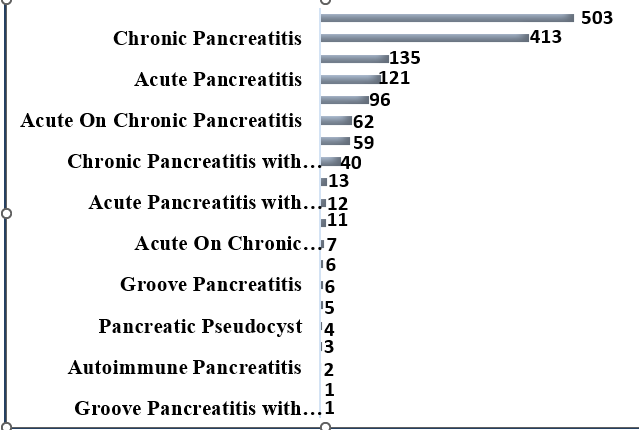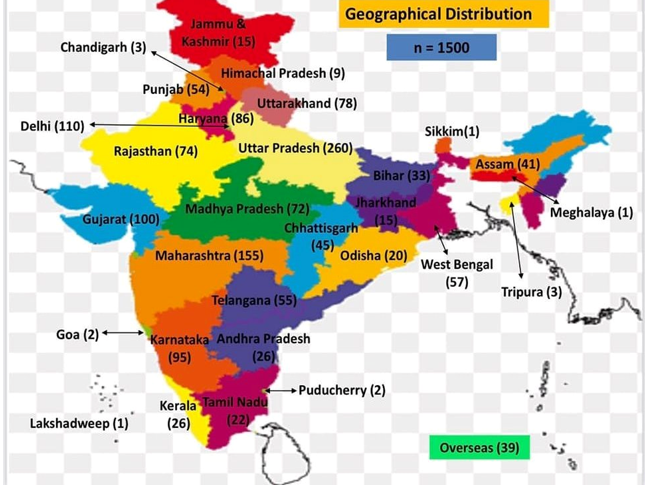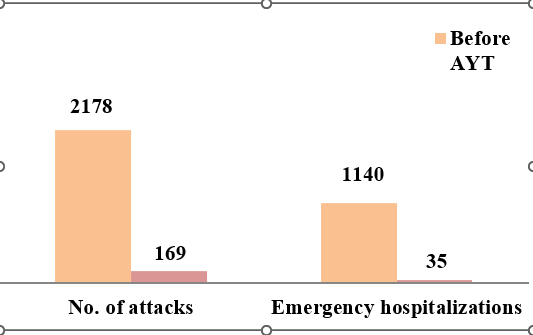Clinical Significance of An Ayurvedic Treatment Protocol in The Patients of Pancreatitis – A Hospital Based Observational Study
Vaidya Balendu Prakash1*, Vaidya Shikha Prakash2 and Sneha Sati1
1VCPC Research Foundation, Uttarakhand India.
2Padaav Speciality Ayurvedic Treatment Centre, Uttarakhand, India.
*Corresponding Author:Vaidya Balendu Prakash, Prakash Villa, Beside Rave Cinemas, NH 74, Rudrapur, Uttarakhand, India, Tel: 9837028544; Fax: 9837028544; Email id: balenduprakash@gmail.com
Citation: Vaidya Balendu Prakash, Vaidya Shikha Prakash, Sneha Sati (2022) Clinical Significance of an Ayurvedic Treatment Protocol in the Patients of Pancreatitis – A Hospital Based Observational Study. Gastroenterol Hepatol J 5: 128.
Received: November 18, 2022; Accepted: November 24, 2022; Published: November 28, 2022
Copyright: © 2022 Vaidya Balendu Prakash, et al. This is an open-access article distributed under the terms of the Creative Commons Attribution License, which permits unrestricted use, distribution, and reproduction in any medium, provided the original author and source are credited.
Abstract
Pancreatitis is the inflammatory condition of the pancreas. The incidences of Pancreatitis are on a rise and its prevalence globally increased by more than two folds from 3,038,787 in 1990 to 6,115,833 in 2017. The disease is broadly classified into acute and chronic pancreatitis. Various other subtypes of the disease have also been described based on its cause, complications, clinical course and pathophysiology. Some of these subtypes are more cumbersome to manage, highly progressive and may even be fatal. In spite of medical advancements, the treatment options have their share of limitations along with substantial physical, emotional and financial burden on the patient. This often leads to patients looking for alternative treatments. It is more common in the Indian scenario where Ayurveda, Yoga, Unani, Siddha and Homeopathy are officially recognised as alternative systems of medicine. In the given background, a North India based Ayurvedic centre has reported significant and long-term relief in patients who have undergone Ayurvedic treatment. Here, the data of 1500 patients of different variants of Pancreatitis from the clinic is being presented. Of these, 768 patients have completed one-year treatment. An analysis of the data shows that Ayurvedic treatment brought significant and sustainable reduction in the frequency and intensity of Pancreatitis attacks in these patients.
Keywords
Pancreatitis, Ayurvedic Treatment, Chronic, Acute.
Introduction
Pancreatitis refers to inflammation of the pancreas. It results from auto-digestion of pancreatic tissues by its own enzymes [1]. The disease is broadly classified as Acute and ChronicPancreatitis. While Acute Pancreatitis refers to short term inflammation of the pancreas, long standing inflammation of the pancreas marked by structural changes is termed as Chronic Pancreatitis [2]. Signs and symptoms of the disease include epigastric pain, vomiting, nausea, steatorrhea, and weight loss. Other associated symptoms are flatulence, bloating, poor blood sugar control, fatigue, back pain, and anemia.
Although Pancreatitis has no established cause, various factors like gallstones, heavy alcohol use, genetic disorders of pancreas, certain medicines, viral or parasitic infections, abdominal injury, pancreatic divisum, etc have been widely indicated to contribute to the disease condition [3]. Causes of Chronic Pancreatitis can be classified as toxins, idiopathic, genetic, autoimmune, recurrent acute attacks and obstruction of pancreatic ducts, known as the TIGAR-O factors [4]. Various complications like necrosis, calcification, pseudocyst, abscess, hemorrhage, obstruction, etc might be associated with the disease.
Pancreatitis has various subtypes based on factors like disease presentation and complications or cause of the disease. The variant of Pancreatitis diagnosed also affects the treatment and prognosis. Conventional management of Pancreatitis involves fluid replacement by administering IV fluids and about five days of no oral feed. Painkillers, including acetaminophen and non-steroidal anti-inflammatory drugs (eg, diclofenac, ibuprofen, naproxen) as first line treatment, followed by non-opioid analgesics, weak opioids (eg, tramadol, codeine) and then strong opioids (eg, morphine, oxycodone, fentanyl) are provided for pain management as per the severity of pain. Pancreatic enzyme supplements are used to treat enzyme insufficiency. Antibiotics are given if another source of infection is suspected and for treatment of fluid collections and necrosis before drainage. Antioxidant supplements may also be helpful, especially in patients with non-alcoholic Chronic Pancreatitis. In cases where medical therapy fails to provide relief, endoscopy, drainage procedures, surgical resection or a combination of these may be used. Patients with Chronic Pancreatitis may require invasive treatment such as endoscopy or surgery in about 40-75% cases [5].
In the stated background, an Ayurvedic Treatment Protocol (ATP) has reportedly brought significant improvement in patients of different variants of Pancreatitis using Ayurvedic Treatment Protocol (ATP).
A total of 1500 patients suffering from different variants of Pancreatitis were enrolled between January 1997 and August 2022. Of these, about 82% were male and 18% were females. The patients belonged to different age groups. 3.27% patients were less than eleven years of age, 11.60% patients were in the age group of 11 to 18 years, 76.46% patients were in the age group of 19 to 45 years and 8.67% patients were more than 45 years old.
These patients were diagnosed by gastroenterologists at various reputed hospitals for different variants of Pancreatitis using blood tests, Ultrasound, CT scan, MRCP or ERCP (Figure 1). These patients had disease history ranging from one month to twenty-five years. Interestingly, 80.93% were non-tobacco users, 66.87% were non-alcoholic and 93.20% had no family history of the disease. These patients belonged to various parts of the country and few were from overseas as well (Figure 2).
Figure 1: Variants of Pancreatitis diagnosed in the enrolled patients (n=1500).

Figure 2: Geographical distribution of the enrolled patients (n=1500).

A random analysis of expenses done in emergency hospitalizations, follow ups, investigations and indirect expenditures by patients (n=1210) showed that the patients spent an average of nearly INR six lacs four thousand (INR 6,04,000/-) on management of the disease before opting for ATP. The enrolled patients were asked to provide their pervious medical records for review and undergo fresh radiological (MRCP) and pathological tests (hemogram, liver function, kidney function, lipid profile, glycosylated hemoglobin, serum Vitamin D3 and B12) to confirm the disease and overall health status.
Patients were admitted for three weeks supervised indoor treatment at the center after noting medical summary and performing clinical evaluation. The treatment comprised of some herbo mineral formulations along with a regulated diet and lifestyle. The main herbo mineral formulation used in the protocol was Amar. Amar was prescribed at a dose of 4 mg per kg body weight, divided into three doses and was given with meals. Amar is prepared using the concepts of Rasa Shastra in Ayurveda using Mercury, Copper and Sulphur with Luffa echinata, Clitoria ternatea and lemon juice. Other medicines were given based on the individual symptoms and investigation reports of the patients. Each patient was given a 1600 to 2200 calorie daily diet, rich in protein and dairy products, divided into three meals and three snacks. The diet was devoid of aerated drinks, caffeinated beverages, alcohol, onion, tomato, garlic, refined flour, packaged, precooked and reheated food. Patients were advised to take complete mental and physical rest. At the onset of ATP, each patient was dewormed using Tablet Albendazole 400 mg. The patients who had low levels of Vitamin D3 and Vitamin B12 were put on weekly dose of 60,000 IU Cholecalciferol syrup and a daily supplement of Methylcobalamin 1500 mcg with breakfast respectively for two months. Vitamin D3 and B12 tests were repeated again after two months and the supplements were stopped or continued based on the results. Pancreatic enzymes were stopped for all patients from the start of the treatment. Patients suffering from diabetes and hypertension were advised to continue anti-diabetic and anti-hypertensive medicines in consultation with their physicians.
After three weeks, the patients were discharged from the center and the same treatment was continued. As follow up, each patient was closely monitored over phone or mail on daily basis. For the entire year, refill batches of medicines were dispatched by courier. At the end of the year, patients were called for physical, pathological and radiological revaluation.
Observations
Of the 1500 patients, 768 patients have completed one year treatment while 259 patients are on treatment. 39 patients did not start the treatment and 24 patients died during the treatment. Eleven patients were lost to follow up, three patients reported progression of the disease and 396 patients dropped out and did not complete the treatment.
Impact evaluation of ATP in the patients who completed one-year treatment showed marked reduction in number of attacks and hospitalizations (Figure 3). Of the 768 patients who completed one year treatment, nine patients dropped out after relapse of the disease and six patients died.
Figure 3: Impact of ATP (n=768); p-value<0.0001. Statistical analysis done using Wilcoxon signed rank test for paired observations, Mc Nemar’s test and paired t test.

CA19-9 lowering effect of ATP
Carbohydrate Antigen 19-9 (CA19-9) is a tumor marker for pancreatic cancer and is also known to promote
Pancreatitis and Pancreatic Cancer [5] The normal value of CA19-9 in 1 mL blood is less than 37 units whereas, levels above 300 U/mL blood are considered definite sign of pancreatic cancer [2].
A data on 148 patients of Pancreatitis with elevated CA19-9 levels (ranging 37 to 10,000 U/mL) has shown that ATP brings a reduction in CA19-9 levels. The downtrend is seen to begin within the first ten days of treatment [6]. Increase in CA19-9 levels after starting Ayurvedic treatment was seen in only 2.7% cases.
Discussion
Pancreatitis is an inflammatory disorder of the pancreas that is characterized by irreversible structural changes. The disease is progressive but unpredictable in nature. Even a single attack of Acute Pancreatitis could turn into Chronic Pancreatitis [7]. Diagnosis of CP is equivalent to a lifetime of pain and gastrointestinal symptoms, apart from periodic acute exacerbations in most cases.
In the stated scenario, a North India based Ayurvedic centre has shown promising outcomes in Pancreatitis patients treated using ATP. [8,9]. Observations from the study reveal that contrary to the widely accepted idea that Pancreatitis is a disease of alcoholics and tobacco users and those with a family history, Pancreatitis is equally common and in fact, more prevalent among non-alcoholics, non-tobacco users and those with no family history of the disease. Our data also shows that incidences of Pancreatitis are widely distributed all over the country rather than being limited to the southern part, as deduced in certain studies.
However, our findings are on similar lines to a few studies that have indicated mineral deficiency and protein malnutrition to be the causative factors for Pancreatitis [10]. ATP comprises of Amar, a herbo-mineral Ayurvedic formulation, along with a regulated diet and lifestyle. Amar is devoid of any free metals and is completely safe for human consumption [11]. No grade II toxicity has been reported in the patients who have undergone ATP. Experimental studies carried on animal models have confirmed the pancreatitis protective properties of Amar [9-15]. The formulation also exhibits CA19-9 lowering effect in patients of Pancreatitis with elevated levels. CA19-9 is not only a marker to assess pancreatic cancer but is also becoming known as a precursor to cancer pancreas.
The results of this study show strong evidences of the efficacy of ATP in patients suffering from different variants of Pancreatitis. Further interdisciplinary studies are required to establish ATP as a treatment option for the patients of Pancreatitis.
Conclusion
ATP has been successful in bringing significant relief in Pancreatitis patients and needs to be developed scientifically.
Conflict of interest
Authors declare no conflict of interest.
References
- Banks PA, Conwell DL, Toskes PP (2010) The Management of Acute and Chronic Pancreatitis. Gastroenterology & Hepatology 6: 1–16.
- Bedi MMS, Gandhi MD, Jacob G, Lekha V, Venugopal A, et al. (2009) CA 19-9 to differentiate benign and malignant masses in chronic pancreatitis: is there any benefit. Indian Journal of Gastroenterology 28: 24–27.
- Weiss F Laemmerhirt, F Lerch, Markus M (2019) Etiology and Risk Factors of Acute and Chronic Pancreatitis. Visceral Medicine 35.
- Etemad B, Whitcomb DC (2001) Chronic pancreatitis: Diagnosis, classification, and new genetic developments. Gastroenterology 120: 682–707.
- Perkins, GL, Slater ED Sanders, G K Prichard, JG (2003) Serum tumor markers. American Family Physician 68: 1075–1082.
- Prakash VB et al. (2020) CA19-9 Lowering Effect of Ayurvedic Mineral Complex in the Patients of Chronic Pancreatitis. EC Gastroenterology and Digestive System 7: 01-05.
- Turner R (2013) Acute Pancreatitis is a Chronic Disease. Pancreatic Disorders & Therapy 03.
- Prakash, Vaidya Balendu et al. (2017) “Relevance of metal based Ayurvedic formulations in the management of recurrent acute/ chronic pancreatitis,”. TANG [HUMANITAS MEDICINE] 7: 9.1-9.6.
- Prakash VB, Tiwari S, Prakash S Sharma S (2019) Anti-Inflammatory Properties of a Processed Copper Complex in L-Arginine Induced Pancreatitis - Two Experimental Studies. EC Gastroenterology and Digestive System 6: 519-524.
- Sawant P (2005) Medicine Update.
- Prakash V, Prakash V Sharma, S Tiwari (2020) Transformation of Copper into therapeutic mineral complex following principles of Rasa Shastra. Annals of Ayurvedic Medicine 9: 162.
- Engle, Tiriac, H.Rivera, Pommier, Gimotty, et al. (2019) The glycan CA19-9 promotes pancreatitis and pancreatic cancer in mice. Science 364: 1156–1162.
- Lynm C (2012) Pancreatitis. Jama 307: 1542.
- Roch A (2014) Chronic pancreatitis: A surgical disease? Role of the Frey procedure. World Journal of Gastrointestinal Surgery 6: 129.
- VBP, SP, SS, ST (2018) Impact Evaluation of Ayurvedic Treatment Protocol on Three Hundred Nineteen Cases of Different Variants of Pancreatitis. Pancreatic Disorders & Therapy 08.
